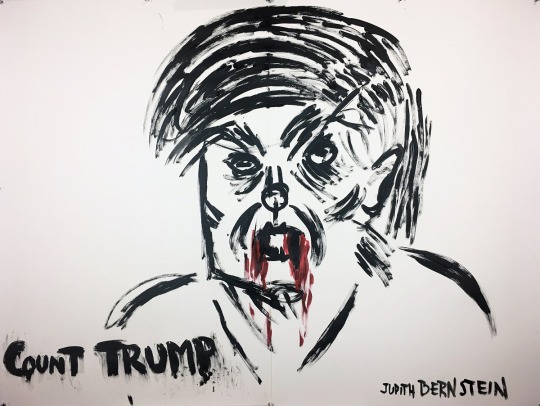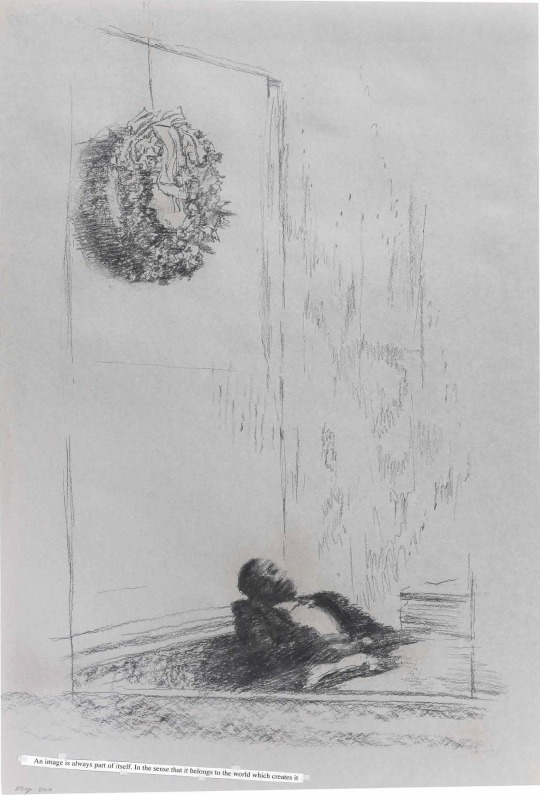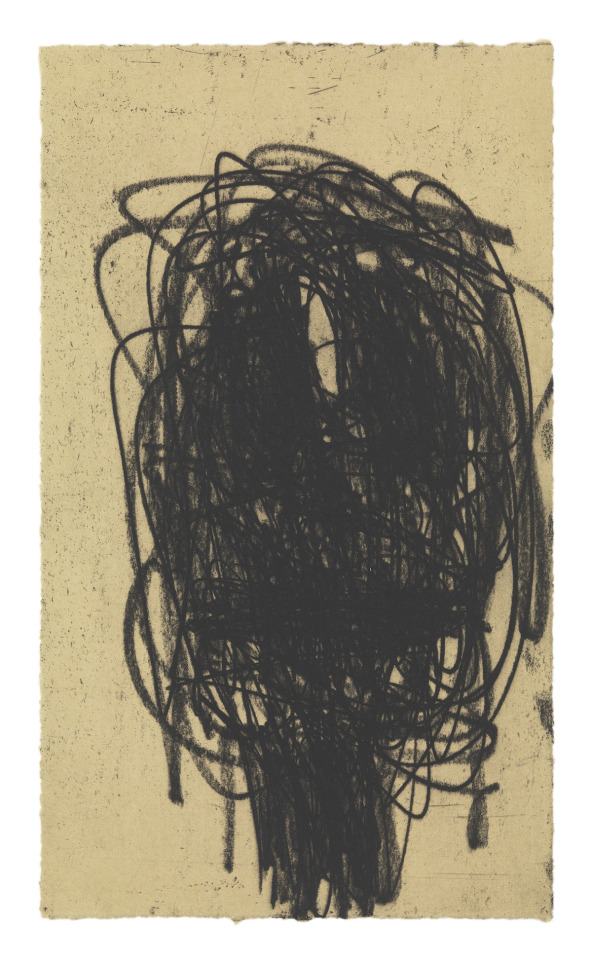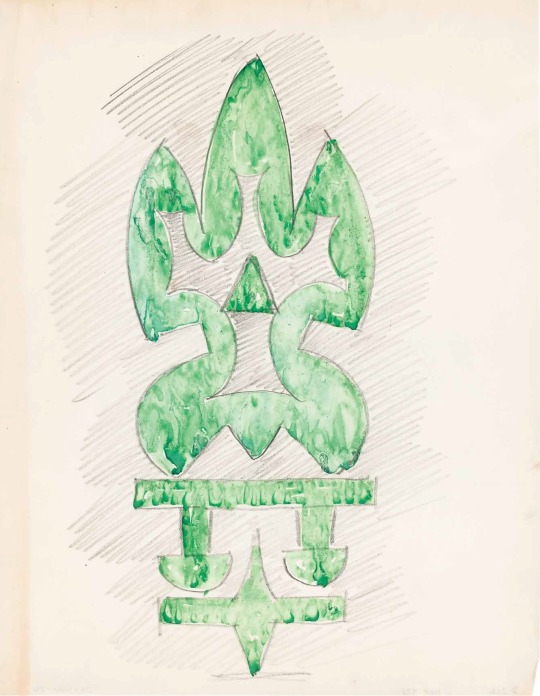Text

A Page from the Drawing Papers Archive
This page from Drawing Papers 139 features Stoic Stack Guy, a gouache on paper created by Jennifer Wynne Reeves in 2005.
The 2018 exhibition Jennifer Wynne Reeves: All Right for Now featured the work of the late artist who developed a reputation as an artist’s artist, garnering an intense and loyal following especially among fellow artists who appreciated her ability to load errant scribbles and globs of crusty paint with humor, narrativity, and poignant emotional affect. Reeves’ works on paper, Masonite, and wood, as well as notebooks and text pieces (Reeves wrote copiously and had a large fan base on Facebook), are a testament to the power of line and color to render accessible deeply personal fears and desires.
The Drawing Papers are a series of publications documenting The Drawing Center’s exhibitions and public programs and providing a forum for the study of drawing.
-Kara Nandin, Bookstore Manager
43 notes
·
View notes
Text

A Page from the Drawing Papers Archive
This page from Drawing Papers 138 features The Treatment 8A, a pen ink and pencil on paper drawing created by Toyin Ojih Odutola in 2015.
The 2018 group exhibition For Opacity: Elijah Burgher, Toyin Ojih Odutola, and Nathaniel Mary Quinn brought together portrait drawings by the three artists that explore diverse identities through each of their entirely distinct stylistic approach and personal background. The three artists are connected by the way in which they use drawing to investigate subjecthood as well as its resistance to depiction. Indeed, Burgher, Ojih Odutola, and Quinn embrace drawing because it invests surface with the felt intimacy of touch while nonetheless confirming it to be a malleable and uncertain construct. Ultimately, in the intellectual tradition of French theorist Édouard Glissant, these artists believe that the right to refuse explanation is as integral to the formulation of selfhood as is revelation.
The Drawing Papers are a series of publications documenting The Drawing Center’s exhibitions and public programs and providing a forum for the study of drawing.
-Kara Nandin, Bookstore Manager
19 notes
·
View notes
Text
A Page from the Drawing Papers Archive
This page from Drawing Papers 136 features a detail of Bulwark #5, a graphite, ink, metal leaf, metal tape, and color pencil drawing on Fabriano 4 paper made by Hipkiss in 2017.
The 2018 exhibition Hipkiss: Bulwark was the artists’ duo first solo museum show in New York and presented the most recent cycle of drawings in their series The Towers (2015–ongoing). The drawings pull from the myriad allegorical significance of towers as symbols for transcendence, irrational ambition, and piety. Praised for their meticulously-detailed panoramic landscapes, the Anglo-French artists Alpha and Chris Mason, known collectively as Hipkiss, have been collaborating for three decades on intricate drawings that interweave dystopian narratives with a personal lexicon of symbolic forms.
The Drawing Papers are a series of publications documenting The Drawing Center’s exhibitions and public programs and providing a forum for the study of drawing.
-Kara Nandin, Bookstore Manager

48 notes
·
View notes
Text
A Page from the Drawing Papers Archive
This page from Drawing Papers 135 features an untitled graphite on paper drawing created by Terry Winters in 2007.
The 2018 exhibition Terry Winters Facts and Fictions (on-view now at The University Museum of Contemporary Art at UMass Amherst through April 28, 2019) presents an overview of Winters’ drawings from 1980 to the present that represent the patterns and schema that undergird physical and intellectual life. Winters’s drawings of grids, networks, and knots illustrate complex encounters between biological drives, technological systems, and mental processes. Featuring full cycles of drawings as well as a selection of large-scale works on paper, the exhibition foregrounds the overarching theme of Winters’s practice: the desire to make sense, however fictively, of the manner in which the visible world is constructed and received.
The Drawing Papers are a series of publications documenting The Drawing Center’s exhibitions and public programs and providing a forum for the study of drawing.
-Kara Nandin, Bookstore Manager

9 notes
·
View notes
Photo

A Page from the Drawing Papers Archive
This page from Drawing Papers 134 features an untitled oil paint, ink, and graphite on paper drawing created by Eddie Martinez in 2016.
The 2017 exhibition Eddie Martinez: Studio Wall imitates the artist’s studio in which he maintains a “drawing wall,” wherein sketches ranging in size, shape, and material serve simultaneously as a source of inspiration and data bank for the artist’s incessant imaginative output. The gallery walls were papered with thousands of sketches along with several large drawings and paintings hung on top of these sketches. Stylistically evocative of mid-century abstraction, Martinez’s drawings bring their own complexity, plugging a rotating cast of characters into raw, vigorously-drawn landscapes: cartoon ducks, oversized eyes, coiled snakes, and anthropomorphic blocks of color are among his itinerant motifs.
The Drawing Papers are a series of publications documenting The Drawing Center’s exhibitions and public programs and providing a forum for the study of drawing.
-Kara Nandin, Bookstore Manager
13 notes
·
View notes
Text

A Page from the Drawing Papers Archive
This page from Drawing Papers 133 features Count Trump, an acrylic on paper drawing created by Judith Bernstein in 2017.
The 2017 exhibition Judith Bernstein: Cabinet of Horrors presented a new body of drawings and paper murals made since Donald J. Trump was elected president in November 2016. Bernstein began engaging with social issues in her practice during the 1960s creating anti-Vietnam drawings, monumental phalluses, and pieces consisting entirely of her own signature. Bernstein’s newer work uses Trump’s own insult-driven, childlike syntax and language to transform her anger, disgust, critique, and disapproval of the current administration into powerful graphic and text-based works.
The Drawing Papers are a series of publications documenting The Drawing Center’s exhibitions and public programs and providing a forum for the study of drawing.
-Kara Nandin, Bookstore Manager
3 notes
·
View notes
Text
A Page from the Drawing Papers Archive
This page from Drawing Papers 132 features Blue and Orange Nudibranch, a watercolor on paper created by Else Bostelmann in1931.
The 2017 exhibition Exploratory Works: Drawings from the Department of Tropical Research Field Expeditions brought together scientific renderings of deep sea creatures, Amazonian animals, and tropical plant life created during field investigations led by legendary scientist William Beebe. Taking the lab into the jungle, and notably hiring women as scientists and illustrators, Beebe pioneered the methodology used to conduct biological research and redefined notions of ecology and nature. With the help of women artists observing and recording the creatures with attentive detail and exquisite accuracy, Beebe and his team helped popularize science and garner public interest in biology.
The Drawing Papers are a series of publications documenting The Drawing Center’s exhibitions and public programs and providing a forum for the study of drawing.
-Kara Nandin, Bookstore Manager

44 notes
·
View notes
Text
A Page from the Drawing Papers Archive
This page from Drawing Papers 131 features Expectations Gatha, a marker on gridded notecard drawing created by Jackson Mac Low in 1978.
The 2017 exhibition Jackson Mac Low: Lines–Letters–Words, spans the multidisciplinary artist’s practice from the 1940s to the 2000s. Mac Low, who is known for composing poetry through chance procedures and automatism, first experimented with these creative processes in his drawings. In his Gathas series of drawings, one of which is seen here, Mac Low emphasizes the visual and aural qualities of written languages, acting as both graphic representations and performance scores.
The Drawing Papers are a series of publications documenting The Drawing Center’s exhibitions and public programs and providing a forum for the study of drawing.
-Kara Nandin, Bookstore Manager

9 notes
·
View notes
Text

A Page from the Drawing Papers Archive
This page from Drawing Papers 130 features Cuentas [Necklace], an ink on paper drawing created by Mateo López in 2016.
The 2017 exhibition Mateo López: Undo List was a multidisciplinary installation that featured works on paper, sculpture, performance, and projected film. Trained as an architect in his native Bogotá, López has long used drawing as a conceptual tool to cross disciplines and aesthetic categories. López contends that just as everything manufactured was at one point a drawing, like a building or designed object, so too, “an image is not flat; it is an atmosphere, it contains time and space.” Some of the creative ways he uses to reveal drawing as such includes trompe l’oeil paper renderings of two-dimensional objects (for example, near-exact replicas of lined sheets of paper); drawings made out of the leftovers produced by cutting into other works; and making three-dimensional drawings of three-dimensional objects by folding paper into sculptures. As seen here in his 2016 drawing “Cuentas,” López plays with conceptions of space by using the two-dimensionality of drawing to depict a three-dimensional necklace.
The Drawing Papers are a series of publications documenting The Drawing Center’s exhibitions and public programs and providing a forum for the study of drawing.
-Kara Nandin, Bookstore Manager
109 notes
·
View notes
Text

A Page from the Drawing Papers Archive
This page from Drawing Papers 129 features Untitled (An Image), a charcoal and collage drawing on paper created by Olga Chernysheva in 2016.
The 2016 exhibition Olga Chernysheva: Vague Accent featured a series of drawings that Chernysheva made during a month-long visit to New York City. The scenes she depicts are ordinary but convey the collusion of interior and public lives. Drawing subway stations, museums, and city streets, Chernysheva’s attentive and observant works lay bare the impossibility of separating inner and outer life. As seen here in an untitled drawing, a doorman that has fallen asleep at his post is both on the clock and withdrawn into his dreams.
The Drawing Papers are a series of publications documenting The Drawing Center’s exhibitions and public programs and providing a forum for the study of drawing.
-Kara Nandin, Bookstore Manager
33 notes
·
View notes
Text

A Page from the Drawing Papers Archive
This page from Drawing Papers 127: Gabriel de la Mora Sound Inscriptions on Fabric features B-145, a vintage radio speaker fabric installed by Gabriel de la Mora in 2015.
For the 2016 exhibition Gabriel de la Mora: Sound Inscriptions on Fabric, de la Mora presented fifty-five pairs of found speaker screens. Describing the objects as caches for historical information about everyday life, each screen is uniquely imprinted with an inscription created by the dust and air that circulated through the speaker during its life including music, voices, broadcasts, and silence.
The Drawing Papers are a series of publications documenting The Drawing Center’s exhibitions and public programs and providing a forum for the study of drawing.
-Kara Nandin, Bookstore Manager
22 notes
·
View notes
Text

A Page from the Drawing Papers Archive
This page from Drawing Papers 126 features Drop Drawing, a graphite on paper drawing created by William Anastasi in 1997.
The 2016 exhibition Drawing Dialogues: Selections from the Sol LeWitt Collection featured over one hundred works from LeWitt’s esteemed collection with a core focus on minimal and conceptual drawing. Exploring cross-connections among key artists featured in the collection like Mel Bochner, Hanne Darboven, Eva Hesse, and Lawrence Weiner, the exhibition also presented older artists that influenced Lewitt’s practice. Featured here is a drawing by William Anastasi, one of the LeWitt’s peers who similarly embarked on a conceptual investigation of art and objecthood.
The Drawing Papers are a series of publications documenting The Drawing Center’s exhibitions and public programs and providing a forum for the study of drawing.
-Kara Nandin, Bookstore Manager
24 notes
·
View notes
Text

A Page from the Drawing Papers Archive
This page from Drawing Papers 124 features Untitled (Hospital), an oil on canvas painting made by Jennifer Bartlett in 2012.
The Drawing Center’s 2016 exhibition “Jennifer Bartlett: Hospital” was the first museum exhibition of a series of ten pastels made in 2012. The works are based on a series of photographs that Bartlett took during an extended stay at Greenberg Pavilion at New York-Presbyterian Hospital / Weill Cornell Medical Center in New York. With Hospital, Bartlett continues her long-established practice of close observation and responsiveness to her environment, and mine the liminal experience of "hospital time," characterized by long periods of waiting interspersed with highly organized routines of treatment, medication, and physical therapy. This combination of boredom and activity often heightens one's awareness of details, and Bartlett exploits these sensations to create images that eschew sentimentality while remaining indelibly poignant.
The Drawing Papers are a series of publications documenting The Drawing Center’s exhibitions and public programs and providing a forum for the study of drawing.
-Kara Nandin, Bookstore Manager
39 notes
·
View notes
Text

A Page from the Drawing Papers Archive
This page from Drawing Papers 124 features Energy Scaffolds and Information Architecture (Pure Potential No. 1), a colored pencil and graphite on antique ledger book pages drawing created by Louise Despont in 2015.
The Drawing Center’s 2016 exhibition “Louise Despont: Energy Scaffolds and Information Architecture” was the first solo museum exhibition for Louise Despont, an artist best known for using compasses, stencils, and rulers to create intricate and deeply meditative drawings on ledger paper. Despont’s series of eight Pure Potential drawings, the first of which is featured here, represent the transition of energy from formlessness into form.
The Drawing Papers are a series of publications documenting The Drawing Center’s exhibitions and public programs and providing a forum for the study of drawing.
-Kara Nandin, Bookstore Manager
149 notes
·
View notes
Text

A Page from the Drawing Papers Archive
This page from Drawing Papers 123 features an untitled softground etching printed in black on somerset velvet antique white made by Rashid Johnson in 2015.
The Drawing Center’s 2015 exhibition “Rashid Johnson: Anxious Men” featured a new series of black-soap-and-wax-on-tile portraits that Johnson calls his “anxious men.” Executed by digging into a waxy surface, they enact a kind of drawing through erasure and represent the first time Johnson has worked figuratively outside of photography or film. Personal in nature, the exhibition catalogue features poetry by his mother Cheryl John-Odim.
The Drawing Papers are a series of publications documenting The Drawing Center’s exhibitions and public programs and providing a forum for the study of drawing.
-Kara Nandin, Bookstore Manager
29 notes
·
View notes
Text

A Page from the Drawing Papers Archive
This page from Drawing Papers 122 features an untitled graphite and wash drawing created by Richard Pousette-Dart in the 1930s.
The Drawing Center’s 2015 exhibition was the first in-depth consideration of Richard Pousette-Dart’s drawings from the 1930s, a period when the artist pursued directly-carved sculpture, yet also painted, experimented with photography, and created numerous works on paper. These early drawings explore Pousette-Dart’s concerns about sculpture and working three-dimensionally, and many reference the figure through full-frontal or profile views as they consider space, orientation, and volume. His numerous studies allude to dance, animal forms, masks, and heads, and many examples offer an accumulation of abstract and geometric forms.
The Drawing Papers are a series of publications documenting The Drawing Center’s exhibitions and public programs and providing a forum for the study of drawing. For more information on Drawing Papers 122 please click here.
-Kara Nandin, Bookstore Manager
9 notes
·
View notes
Text

A Page from the Drawing Papers Archive
This page from Drawing Papers 121 features Portrait de l’aide de camp de Murad Bey a charcoal on paper drawing created by André Dutertre.
The 2015 exhibition Portraits from the École des Beaux-Arts explored four hundred years of portrait drawings, emphasizing work from live models. Forty portraits were chosen from the Beaux-Arts de Paris’ collection based on diverse criteria such as the male and female gestures, caricature, frontal gaze, social class, and profession of the model.
This portrait may be of Ibrahim Bey al-Sannari, who is considered to be one of Murad Bey’s, a famous adversary of General Bonaparte, closest army advisors. The brave fighter is seen in a harsh light that captures the intensity of his expression and the high-stakes that his position involved.
The Drawing Papers are a series of publications documenting The Drawing Center’s exhibitions and public programs and providing a forum for the study of drawing. For more information on Drawing Papers 121 please click here.
-Kara Nandin, Bookstore Manager
15 notes
·
View notes